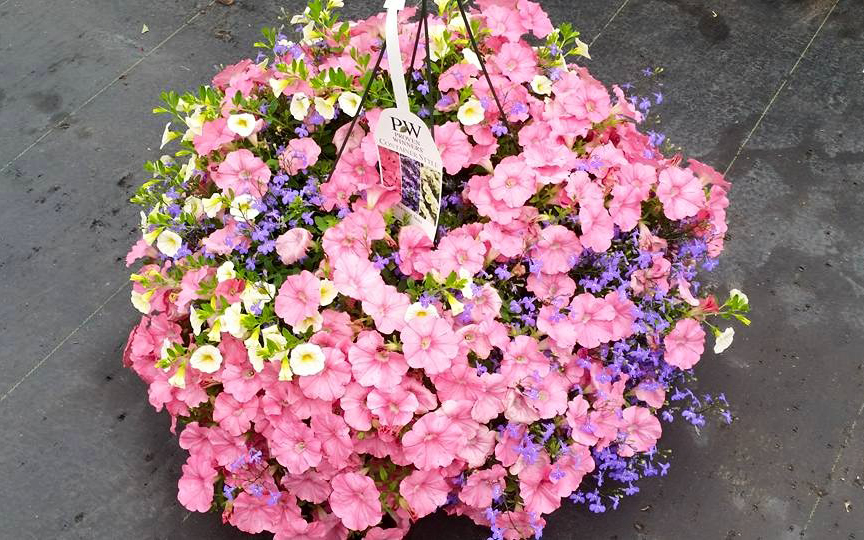
For many in Aroostook County, spring not only means an end to snowstorms, but also time to think about starting a new flower garden.

When starting a new flower garden, Amanda Linscott, owner of Chadwick Florist and Greenhouses in Houlton, recommends superbells as a potentially easy flower for beginners to maintain. (Courtesy of Amanda Linscott)
Donna Keegan, who has owned and operated Myrtle Tree Farm in Presque Isle with her husband C.K. for the past 28 years, recommends that gardeners who are beginners start by finding out what plant hardiness zone their property lies in. Plant hardiness zones are areas that the U.S.Department of Agriculture categorizes based on average low temperatures that plants can survive in.
The University of Maine Cooperative Extension website provides people with the plant hardiness zone map for Maine, which states that most of central Aroostook County and parts of northern and western Aroostook fall under Zone 4A, meaning that the roots of most perennial flowers — those that grow for more than two years of initial planting — can survive in temperatures of 25 to 30 degrees Fahrenheit below zero. Remaining areas of Aroostook fall under Zone 3B, where flowers can live in temperatures of 34 to 37 below zero.
Keegan said that the most important aspect of any garden is putting down soil that contains a balance of organic materials and nutrients to keep flowers healthy throughout spring and summer.
“If you’re new to gardening, the best thing to do would be to clean your area, then add topsoil, cow manure and peat moss. The manure gives the soil extra organic matter and the peat moss gives better texture,” Keegan said. “Peat moss also keeps your soil from being too heavy and helps the nutrients flow through the soil easily.”
At Myrtle Tree Farm, Keegan has been busy preparing for the garden season, during which the business is open from May 1 to mid-October. She typically encourages first-time gardeners to start with perennials such as daylilies, hostas, sedums, bleeding hearts and peonies because those flowers do not require a strict watering schedule and can be planted in either partial or full sunlight.

Donna Keegan of Myrtle Tree Farms in Presque Isle has 10 display gardens at her business every year, including ones with pansies (pictured here) and she loves sharing gardening tips with both new and more experienced gardeners. (Courtesy of Donna Keegan)
For those who find themselves coming back to gardening year after year and want to find flowers that make their garden pop with color, Keegan said that this year she will be introducing new varieties of daylilies such as the bright red and orange “ruby spider” and the “orange smoothie.”
To maintain healthy gardens throughout the summer, she recommends that new gardeners weed regularly and water flowers only in the morning unless the area they live in goes through a particularly long time without rain.
“Watering in the morning gives the plants the entire day to take in the water and spread it through their roots,” Keegan said. “If you’re planting in a hot month like July, you might consider watering in the morning, checking the garden in the late afternoon and just watering the soil at night.”
In Houlton, florist and owner of Chadwick Florist and Greenhouses Amanda Linscott advises new growers to fertilize their flowers on a regular basis and keep an eye out for insects that could potentially harm plants.
She also recommends beginners not set their sights on a garden space that becomes too large and difficult to maintain during the first summer.
“I would start off small with perhaps four or five flower varieties,” Linscott said. “If you are starting with just perennials or annuals, focus on a small amount so that you could learn about these types and add more each year until you’re comfortable mixing things up.”
Linscott said that folks should also consider whether they prefer to grow perennial flowers or annuals, plants that only live for one growing season. Annuals require extra gardening work in the spring because they need to be replanted every season whereas perennials produce seeds and grow year after year.

Geraniums are among the numerous flower varieties that Donna Keegan enjoys sharing with gardeners at Myrtle Tree Farms in Presque Isle. (Courtesy of Donna Keegan)
If gardeners choose to start small, they will likely need only small planting tools such as a trowel, spade and a watering can. Those who want their garden to add curb appeal to their yard can also add mulch, which can help the soil retain moisture without requiring as much manual watering.
But Linscott and Keegan both point out that the most important part of flower gardening is for people to find the flowers they love and have fun watching grow.
“I have a perennial garden that I just started last year and my absolute favorite annual flowers are geraniums,” Linscott said. “After you find a spot you want to garden in and pick out the plants that work best for you, it’s happy planting.”
For Keegan, who has 10 display gardens at Myrtle Tree Farm, including three greenhouses, operating her business means being able to help others experience the joys of planting their own garden.
“It’s very peaceful. People love tending to plants, keeping them alive and watching them grow,” Keegan said. “And those of us who love flowers love sharing our gardens with others.”







